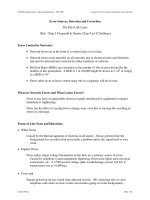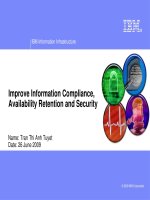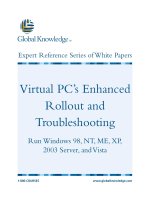Tài liệu POST Guidelines Crowd Management, Intervention, and Control docx
Bạn đang xem bản rút gọn của tài liệu. Xem và tải ngay bản đầy đủ của tài liệu tại đây (2.68 MB, 77 trang )
POST
Guidelines
Crowd Management,
Intervention,
and Control
CALIFORNIA COMMISSION ON PEACE OFFICER STANDARDS AND TRAINING
Forward by
Paul Cappitelli
Executive Director
Commission on Peace Ocer Standards and Training
POST Guidelines
Crowd Management,
Intervention, and Control
POST Guidelines — Crowd Management,
Intervention, and Control
© 2012 by California Commission on Peace
Officer Standards and Training
Published March 2012
All rights reserved. This publication may not be
reproduced, in whole or in part, in any form or
by any means electronic or mechanical or by
any information storage and retrieval system
now known or hereafter invented, with out prior
written permission of the California Commission
on Peace Officer Standards and Training, with
the following exception:
California law enforcement agencies in the
POST peace officer program and POST-
certified training presenters are hereby
given permission by POST to reproduce any
or all of the contents of this manual for their
internal use.
All other individuals, private businesses and
corporations, public and private agencies and
colleges, professional associations, and non-
POST law enforcement agencies in state or out-
of-state may print or download this information
for their personal use only.
Infringement of the copyright protection law and
the provisions expressed here and on the POST
website under Copyright/Trademark Protection
will be pursued in a court of law. Questions
about copyright protection of this publication
and exceptions may be directed to Publications
Manager.
Cover image from shalunts / Shutterstock.com
POST2006TPS-0408
POST Guidelines — Crowd Management, Intervention, and Control
| i
POST Mission Statement
The mission of the California Commission
on Peace Ocer Standards and Training
is to continually enhance the professionalism
of California law enforcement in serving
its communities.
Intentionally blank
POST Guidelines — Crowd Management, Intervention, and Control
| iii
POST Commissioners
Chair
Lai Lai Bui
Detective, Sacramento Police Department
Vice Chair
Jim McDonnell
Chief, Long Beach Police Department
Walter Allen
Member, Covina City Council
Tom Anderson
Public Member
Robert Cooke
Special Agent in Charge
California Narcotic Ocers’ Association
Floyd Hayhurst
Deputy Sheri, Los Angeles County
Ron Lowenberg
Director, Criminal Justice Training Center
Golden West College
John McGinness
Sheri (Retired), Sacramento County
Michael A. Ramos
District Attorney, San Bernardino County
Michael Sobek
Sergeant, San Leandro Police Department
Kamala D. Harris
Attorney General, Ex Ocio Member
Paul Cappitelli
Executive Director
Intentionally blank
POST Guidelines — Crowd Management, Intervention, and Control
| v
Guidelines Development Committee
Dennis Beene
Deputy Chief
California Emergency Management Agency
Ken Bernard
Captain
Sacramento Police Department
Don Bradley
Chief Deputy
Santa Cruz County Sheri’s Oce
Donald Buchanan
Commander
Alameda County Sheri’s Oce
Robert Fonzi
Assistant Sheri
San Bernardino County Sheri’s Department
Robert Gerber
Acting Chief
California Emergency Management Agency
Bob Green
Commander
Los Angeles Police Department
Paul Henisey
Chief
UC Irvine Police Department
Michael Hillmann
Deputy Chief (Ret.)
Los Angeles Police Department
D. R. “Ike” Iketani
Assistant Chief
California Highway Patrol
Roxana Kennedy
Lieutenant
Chula Vista Police Department
Boyd Long
Assistant Chief
San Diego Police Department
Bruce Nalibo
Chief Investigator
Yolo County District Attorney’s Oce
Patrick O’Neill
Sergeant
Eureka Police Department
Nader Oweis
Chief
UC Santa Cruz Police Department
Michael Peters
Lieutenant
Orange County Sheri’s Department
Eugene Ramirez
Attorney
Manning & Kass, Ellrod, Ramirez, and Trester LLP
Carol Ann Rohr
Deputy City Attorney
City of Santa Monica
Tom Schwedhelm
Chief
Santa Rosa Police Department
Robert “R.C.” Smith
Senior Consultant
POST
Erik Upson
Captain
Berkeley Police Department
Robert Wickum
Captain
San Bernardino County Sheri’s Department
Robert Wren
Lieutenant
Orange County Sheri’s Department
Intentionally blank
POST Guidelines — Crowd Management, Intervention, and Control
| vii
Forward
Penal Code §13514.5 requires the Commission on Peace Ocer Standards and
Training to establish guidelines and training for law enforcement’s response to
crowd management. It species that “the guidelines to be developed by the
commission should take into consideration the roles and responsibilities of all law
enforcement ocers responding to acts of civil disobedience.”
These guidelines provide information for law enforcement agencies to consider
when addressing the complexities and broad range of issues related to crowd
management. For the purposes of these guidelines, the general term “crowd
management” encompasses the management, intervention, and control strategies
for a law enforcement response to public assemblies and gatherings that can range
from peaceful/non-violent to unlawful and riotous.
The guidelines are not meant to constitute policy, nor are they intended to establish
a statewide standard. They are solely a resource for law enforcement leaders to
provide foundational guidance for the facilitation of First Amendment rights while
allowing discretion and exibility in the development of individual agency policies.
The information contained in this publication represents the best thinking of
contemporary law enforcement leadership. POST is grateful for the assistance of
the Guidelines Development Committee who generously gave of their time and
expertise.
Questions or comments concerning these guidelines should be directed to the POST
Training Program Services Bureau at 916 227-4885.
Paul Cappitelli
Executive Director
Commission on Peace Ocer Standards and Training
Intentionally blank
POST Guidelines — Crowd Management, Intervention, and Control
| ix
Introduction
I
n the United States all people have the right of free speech and assembly guaranteed
by the First Amendment of the Constitution. The First Amendment states “Congress
shall make no law respecting an establishment of religion, or prohibiting the free
exercise thereof; or abridging the freedom of speech, or of the press; or the right of
the people peaceably to assemble, and to petition the Government for a redress of
grievances.”
A fundamental role of law enforcement is the protection of the rights all people have
to peacefully assemble, demonstrate, protest, or rally. In turn, law enforcement also
has the responsibility to ensure public safety and to protect the lives and property
of all people. The sometimes competing goals of maintaining order while protecting
the freedoms of speech and assembly stand as one of law enforcement’s greatest
challenges.
These guidelines are designed to assist law enforcement leadership in addressing the
many challenges and broad range of issues surrounding a response to incidents of
crowd management. All law enforcement leaders should familiarize themselves with
the guidelines, strategies, terms, and denitions set forth in this document. These are
the generally accepted principles of crowd management, intervention and control,
and should serve to guide a law enforcement agency’s response to both lawful and
unlawful assemblies.
Law enforcement planners should be proactive in consulting with and advising
their jurisdiction’s elected and administrative leaders of the identied strategies
and plans for specic events. Such interactions will help establish responsibility and
accountability at all levels.
Intentionally blank
POST Guidelines — Crowd Management, Intervention, and Control
| xi
Contents
POST Mission Statement i
POST Commissioners iii
Guidelines Development Committee v
Forward vii
Introduction ix
Part 1 Law Enforcement Objectives 1
Guideline 1.1 Law Enforcement Objectives in the 21st Century 1
Guideline 1.2 Principles of Crowd Management 3
Guideline 1.3 Community Stakeholders 5
Part 2 Planning and Preparation 7
Guideline 2.1 Incident Command System (ICS) and Standardized Emergency Management Systems (SEMS) 7
Guideline 2.2 Incident/Event Planning 9
Guideline 2.3 Crowd Behavior 13
Guideline 2.4 Mutual Aid & Multi-Agency Coordination 15
Guideline 2.5 Public Agency and Community-Based Resources 17
Guideline 2.6 Training for Managing Crowds 19
Part 3 Information Management 21
Guideline 3.1 Information Gathering and Assessment 21
Guideline 3.2 Incident Documentation 23
Part 4 Roles and Responsibilities 25
Guideline 4.1 Command and Control 25
Guideline 4.2 Leadership Responsibilities 27
Guideline 4.3 Criminal Investigation 29
Part 5 Crowd Control 31
Guideline 5.1 Crowd Management, Intervention, and Control Strategies 31
Guideline 5.2 Dispersal Orders 33
Guideline 5.3 Mass Arrests and Bookings 35
Guideline 5.4 Use of Force: Force Options 39
Guideline 5.5 Use of Nonlethal Chemical Agents 41
Part 6 Media 43
Guideline 6.1 Media Strategies 43
Guideline 6.2 Electronic Communication and Social Media 45
Appendix A Terms and Denitions 47
Appendix B Crowd Management Intervention and Control Strategies 51
Appendix C Applicable Statutes 53
Appendix D Applicable Case Law 57
Appendix E Training and Information Resources 61
Intentionally blank
POST Guidelines — Crowd Management, Intervention, and Control
| 1
PART 1
Law Enforcement Objectives
Discussion: Law enforcement must carefully balance the First Amendment rights and
other civil liberties of individuals with the interventions required to protect public
safety and property. When establishing policies and procedures, every agency should
consider that all persons have the right to assemble, demonstrate, protest, rally,
or perform other activities protected by the First Amendment of the United States
Constitution. Law enforcement has the responsibility to protect the lives and property
of all people. Peace ocers must not be aected by the content of the opinions being
expressed nor by the race, gender, sexual orientation, physical disabilities, appearances,
religion, or political aliation of anyone exercising their lawful First Amendment rights.
They must have the integrity to not let personal, political, or religious views aect how
they perform their duties.
Law enforcement planners should be proactive in consulting with and advising their
jurisdiction’s elected and administrative leaders of the identied strategies and plans for
specic events. Such interactions will help establish responsibility and accountability at
all levels.
Issues to consider (not in priority order):
Protection of Constitutional rights
Fair and impartial enforcement of laws
Protection of life and property
Protection of vital facilities
Prosecution of violators
Public and peace ocer safety
Potential for disruption to commerce and community aairs
Establish policies and procedures
that recognize and address law
enforcement objectives and
provide for the legal protection
of the Constitutional rights of
allpersons.
Guideline
1.1 Law Enforcement Objectives in the 21
st
Century
Guideline
Intentionally blank
POST Guidelines — Crowd Management, Intervention, and Control
PART 1 Law Enforcement Objectives | 3
Discussion: Any public assembly or gathering, whether for lawful or unlawful purposes,
may require the response of law enforcement. The response can range from observation
to engaging in various crowd management strategies.
Not all crowd situations involve unlawful behavior. Law enforcement’s responsibility is
to objectively discern at what juncture a demonstration leaves the realm of legal protest
and becomes an abridgement of the rights of others. Law enforcement should seek
to facilitate lawful expression by groups who are present even when unlawful activity
occurs. The goal should be to protect lawful activity while identifying and isolating
unlawful behavior.
Eective response to crowd management events necessitates adherence to certain
foundational principles (not in priority order):
Leadership
Knowledge of Constitutional law
Knowledge of law and agency policies as they relate to use of force and
information gathering
Proper planning
A willingness to reach out to protest groups and stakeholders
Using time, patience, and communication to attempt to facilitate lawful protest
activities and obtain voluntary compliance when feasible
Use of the Incident Command System (ICS) and Standardized Emergency
Management System (SEMS) to maximize proper command and control
Appropriate use of the mutual aid system (see Guideline 2.4, page 15)
Seeking support of community and public agency resources
Training
Situational awareness
Proper incident documentation
Thorough and complete criminal investigations
Eective strategies and tactics
Objectively reasonable use of force
Liaison with the media and a well-managed media relationship
Understanding and working with social media and electronic communication
Establish policies and procedures
designed for eective response
by law enforcement to crowd
management events.
Guideline
1.2 Principles of Crowd Management
Guideline
Intentionally blank
POST Guidelines — Crowd Management, Intervention, and Control
PART 1 Law Enforcement Objectives | 5
Discussion: Stakeholder involvement is critical for eective law enforcement response
to crowd management events. Law enforcement should embrace collaboration with
community stakeholders when planning for and responding to public assemblies and
gatherings.
Community stakeholders may include (not in priority order):
Advocacy groups
Business associations
Civil rights organizations
Elected ocials
Labor organizations
Leaders of local/state government
Neighborhood associations
Religious groups/clergy
Schools/colleges/universities
Special interest groups
Establish procedures to identify
and liaise with community
stakeholders for the purpose
of developing relationships,
receiving input, and engaging in
collaborative discussion.
1.3 Community Stakeholders
Guideline
Guideline
Intentionally blank
POST Guidelines — Crowd Management, Intervention, and Control
Use the Incident Command System,
an element of the Standardized
Emergency Management System,
when managing crowds.
Discussion: The ICS is considered the model for managing the response to critical
incidents including crowd management and civil demonstrations. SEMS, established by
Government Code §8607(a), incorporates ICS and must be utilized by law enforcement
agencies to apply for potential reimbursement from the State of California. Law
enforcement’s use of ICS is outlined in the Law Enforcement Guide for Emergency
Operations.
SEMS consists of the following ve organizational levels that are activated as necessary:
1) Field Response
2) Local Government
3) Operational Area
4) Region
5) State
The Field Response Level also consists of ve primary Incident Command System functions:
1) Command
2) Operations
3) Planning/Intelligence
4) Logistics
5) Finance/Administration
The benets of applying the principles of ICS for incident planning and response include:
A unied structure for emergency response
A useful framework for facilitating the planning process
Clarication of roles and planning for an event’s logistics and operations
A structure that can be tailored to t the needs of each agency or event
The Law Enforcement Guide for Emergency Operations can be found on the California
Emergency Management Agency (CalEMA) website at www.calema.ca.gov.
| 7
2.1 Incident Command System (ICS) and Standardized
Emergency Management Systems (SEMS)
PART 2
Planning and Preparation
Guideline
Guideline
Intentionally blank
POST Guidelines — Crowd Management, Intervention, and Control
PART 2 Planning and Preparation | 9
Discussion: Planning and preparation are essential elements of eective crowd
management. The planning process establishes a foundation for informed decision-
making and accountability. For pre-noticed events, agencies have the opportunity to
develop in-depth operational plans. Prior planning experiences and after-action reports
can provide a basic level of guidance and operational consistency when planning for pre-
noticed events and responding to spontaneous incidents.
Law enforcement leaders are encouraged to apply the principles of the Incident
Command System when developing operational plans, to include the use of ICS forms.
Incident/event planning steps may include (not in priority order):
Determining command and control
Identifying incident, operations, and tactical commanders
Outlining the circumstances in which command and control responsibilities
transfers to another level
Identifying stang requirements for department operations center and/or
emergency operations center
Identifying and establishing incident objectives
Developing a exible operations plan
Identifying partner law enforcement agencies (local, state, and federal as applicable)
Considering cross-jurisdictional issues
Contacting police agencies that have prior experience with similar events or groups
Identifying and conferring with other city/county/state agencies that can
contribute logistical support (see Guideline 2.5, page 17)
Determining operational security needs, including:
Counter-surveillance activities
Counter-intelligence activities
Developing protocols for event information gathering and disseminating
Meeting with event organizers
Identify potential protest groups and oering to meet with them
Meeting with advocacy groups and other stakeholders
Initiate incident/event planning
consistent with the Incident
Command System (ICS).
2.2 Incident/Event Planning
Guideline
Guideline









